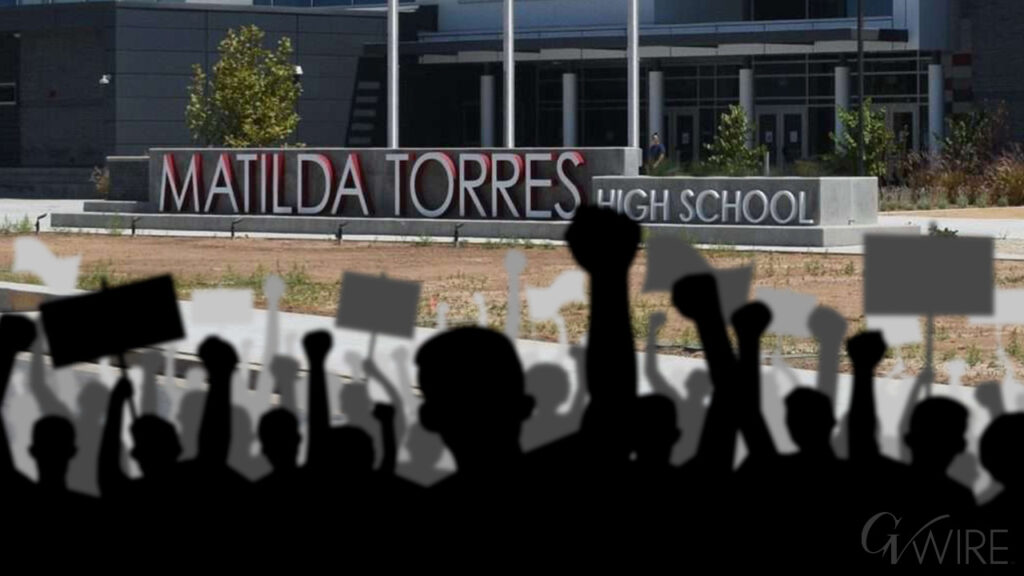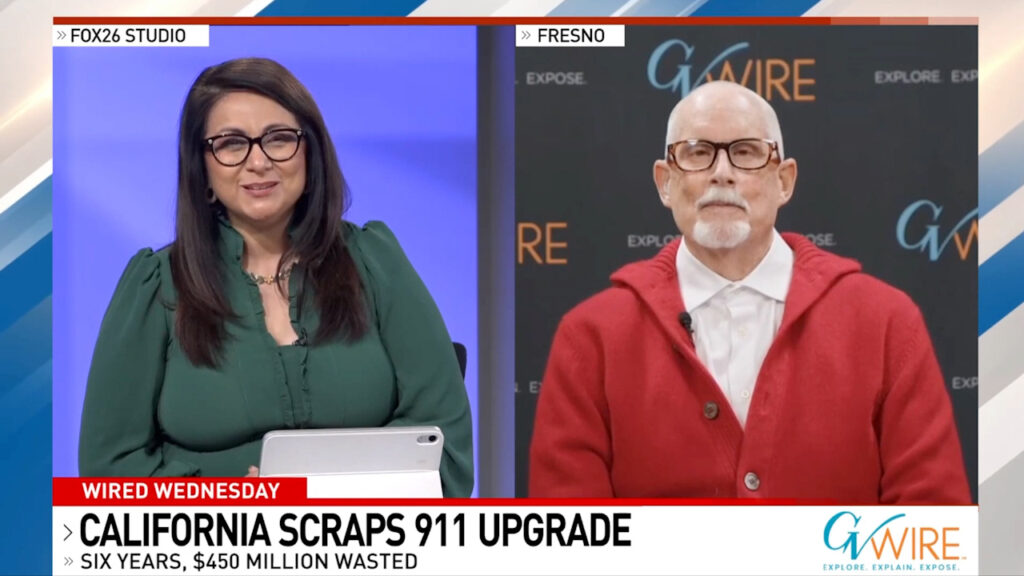New law mandates teaching of Native American history in California schools, including mistreatment and tribal perspectives. (CalMatters/Miguel Gutierrez Jr.)

- California schools to teach Native American history, including genocide and resilience, under new law.
- Tribal leaders advocate for comprehensive education on Native culture, language, and traditions in schools.
- Bill aims to address educational disparities and boost cultural understanding for Native American students.
Share
|
Getting your Trinity Audio player ready...
|
In the 1860s, an armed militia swept into the historic land of the Serrano people in the San Bernardino mountains and went on a killing spree, attempting to slaughter the entire tribe. A tribal leader named Santos Manuel led the surviving 30 members to safety in a nearby valley.

Carolyn Jones
CalMatters
Now, Manuel’s great-great grandson has ensured that every K-12 student in California will learn the story of the Serrano people and other California native tribes who endured atrocities during the Spanish colonial and Gold Rush eras in California history.
“The hope is that students learn the true history of California, the horror and the genocide, but also the resiliency of the Indian people,” said Assemblymember James Ramos, a descendent of Manuel who authored a bill requiring schools to teach about the mistreatment and perspectives of Native Californians in social studies classes.
“It’s time that the voices of California’s first people drive the educational process, especially when the subject is our ways, our people, our history,” said Ramos, who lives on the San Manuel Indian reservation in San Bernardino County and is the first Native Californian to serve in the state Legislature.
Gov. Gavin Newsom signed the bill in September. It goes into effect Jan. 1.
Related Story: K-12 Reading and Math Scores Inch Up, but Still Below Pre-Pandemic Levels
Expanding Fourth Grade History Curriculum
The new law will be most relevant to fourth-graders when they study California history, exploring the stories of California missions, the discovery of gold and statehood — all of which had a profound impact on the indigenous people who’d lived in the region for at least 20,000 years.
The current fourth grade history curriculum covers the plight of Native Californians but it’s only recommended, not required. As a result, lessons vary across school districts, with some students getting scant information – or lessons focused largely on the missions. Under Ramos’ law, lessons on the mistreatment of Native Californians will be mandatory. Some of the information may also be covered in California’s new ethnic studies requirement for high school students, which goes into effect in fall 2025.

Assemblymember James C. Ramos, a Democrat from Highland, who authored the Assembly bill which will require California public schools to teach the impact of the Mission Period and Gold Rush on California Native Americans, shows pine cones to fourth-grade students from Inland Empire schools at the California Indian Cultural Awareness Conference at California State San Bernardino, on Sept. 23, 2024. Photo by Damian Dovarganes, AP Photo
Tribal leaders said they were pleased with the bill, but hope students learn more about Native California history than just the tragedies. Ideally, they said, students should be learning the full breadth of Native history and culture: learning basket techniques in art class, reading Native authors in literature class, studying Native healing practices in health and science classes, and learning Native approaches to environmentalism, politics and economics throughout the entire curriculum.
Related Story: Fresno Trustees Vote 6-1 to OK Project List for $500M Measure H Bond
They’d also like to see schools develop relationships with local tribes, inviting members in to teach the tribe’s history, language and traditions. Students should learn at least some phrases in the local indigenous language, and the school should promote Native culture at every opportunity, they said.
“These stories matter for all Californians,” said William Bauer, a history professor at UC Riverside who specializes in Native Californian studies and is a member of the Round Valley tribe. “I’d hope kids leave school with the idea that California Indians have survived and thrived.”
“The hope is that students learn the true history of California, the horror and the genocide, but also the resiliency of the Indian people.”
Assemblymember James Ramos, democrat from San Bernardino
Shannon Rivers, manager of the nonprofit Indigenous Education Now, a Los Angeles advocacy group, said the bill is much needed, but schools also need to do a better job specifically serving Native students, many of whom are struggling.
Native students lag behind the state average in nearly every measurement, including attendance, graduation rates, math and literacy scores and discipline. One solution, Rivers said, is to create special programs for Native students that focus on their history, language and traditions, which could boost students’ interest in school and help make curriculum more relevant to their lives. His group is currently working with Los Angeles Unified on such a plan.
“It’s important we do this, so Native students have a better understanding of who they are,” said Rivers, a member of the Akimel O’otham tribe in Arizona. “Although the challenge with all these initiatives is that Native people are not monolithic. They’re incredibly diverse, especially in California.”
Disease, Enslavement, Killing
When Spanish missionaries arrived in the late 1700s, at least 300,000 people lived among an estimated 200 tribes scattered in every part of California, making it one of the most densely populated and diverse regions in North America.
But Native numbers began to decline with the arrival of Spanish missionaries, who brought diseases for which Natives had no immunity, including smallpox, malaria and diphtheria. The Spanish also introduced crops and livestock that altered the landscape and created food shortages for tribes. Thousands of native people died when they became enslaved or imprisoned at the missions, where they were forced to work in the fields and convert to Catholicism.
But the most violent period followed the discovery of gold in the Sierra foothills in the mid-1800s. Settlers, private militias and the U.S. troops carried out massacres across California, with the intent of exterminating the Native population. By 1900, only about 16,000 Native Californians remained, many living in small groups away from their original homeland.

Over the next century, the population gradually rebounded and Native people nurtured their culture and traditions, despite being subject to abuse at government-run boarding schools, discrimination, and legal fights over land ownership. By 2020, there were about 1.4 million Californians who identified as at least part Native American, according to the U.S. Census.
The violent history may be difficult to digest, especially for younger children, but schools should find thoughtful, sensitive ways to impart the full story of Native Americans in California, said Joely Proudfit, head of the Native American studies department at Cal State San Marcos.
“The history of California is tragic. It’s brutal. It’s violent. Genocide occurred here,” said Proudfit, who is both Payómkawichum and Tongva, tribes that are indigenous to Southern California. “We need to be honest about our history, so maybe we’ll have some compassion and empathy with what’s happening in today’s world.”
“We need to be honest about our history, so maybe we’ll have some compassion and empathy with what’s happening in today’s world.”
Joely Proudfit, head of the Native American studies department at Cal State San Marcos
She said that high-quality teacher training will be key in making Ramos’ bill a success. Even though the bill does not come with funding, she said the state should set aside money to help teachers learn the material and find effective ways to present it. Currently, Proudfit helps run a nonprofit called California Indian Education for All that provides free and low-cost training for teachers on how to teach about the history, culture and contributions of Native Caifornians. But the task should not rely solely on volunteers, she said.
“A state like ours, with its rich diversity of tribes, is going to need millions upon millions of dollars to create quality curriculum,” Proudfit said. “Asking cultural knowledge-keepers and professionally trained educators to continue to do these things for free is not appropriate. It’s a cultural taxation.”
Related Story: Want a Voice in Fresno Unified’s Budget? Community Meetings Scheduled
‘Innocent Bystanders’
In San Bernardino County, where Ramos’ family has lived for hundreds, if not thousands of years, the story of the 1860s massacre remains fresh. According to documents provided by the San Bernardino Historical and Pioneer Society, the Serrano tribe did not provoke the attack, “they really were innocent bystanders,” said Lyn Killian, a librarian with the historical society.
Four young Paiute Indians from Utah, who had come west with a wagon train, became involved in a tit-for-tat skirmish with some local cowboys that resulted in several deaths and, according to local historians, the Piutes burning a sawmill. For revenge, an armed posse stormed into the Serrano village — even though the Serranos were not involved in the fighting — and chased the inhabitants to Chimney Rock, near Lucerne Valley.

Assemblymember James C. Ramos’ great-great-grandfather, Santos Manuel. (Assemblymember James C. Ramos)
“Despite their cover in the rocks the Indians were wiped out,” according to a 1966 report by a local historian in the San Bernardino Sun-Telegram newspaper. “Posse men went on to destroy the nearby Indian village, even killing women and children. … The peaceful Serrano had taken no part in the mill burning but they were driven from their ancestral home nonetheless.”
After the bloodshed, the remaining members of the tribe moved around the valley, pushed further and further east as more settlers arrived. In 1891, the federal government granted them a reservation and recognized their sovereignty. Last year, the San Manuel tribe had about 200 members, a casino, resort and charity that provides scholarships, after-school programs, housing assistance, environmental restoration, arts and music programs and support for other tribes, among other causes.
“This history is still very much real to all of us, all California Indian people,” Ramos said. “With this bill, we have a chance to share the true accounts of what happened to us. And also that we’re still here, even though we were almost wiped off this earth. I sit now in the state Legislature with Serrano and Cahuilla blood in my veins. … That’s a story people should know.”
About the Author
Carolyn Jones covers K-12 education at CalMatters. A longtime news reporter, she’s covered education for nearly a decade, focusing on everything from special education to state funding policies to inequities in student achievement. She’s won numerous awards from the California Newspaper Publishers Association, and was a finalist in 2020 for beat reporter of the year (small newsroom) by the Education Writers Association.
About CalMatters
CalMatters is a nonprofit, nonpartisan newsroom committed to explaining California policy and politics.
RELATED TOPICS:
Categories

MAHA Activists Urge Trump to Fire His EPA Administrator

Meta Strikes Multiple AI Deals With News Publishers

















